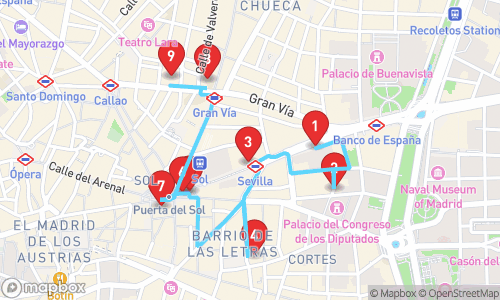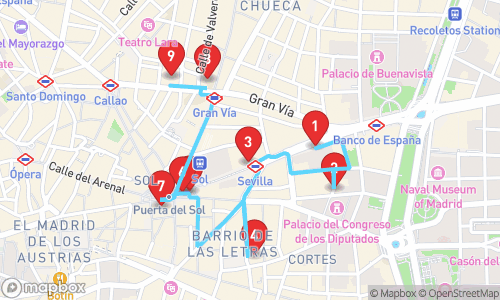
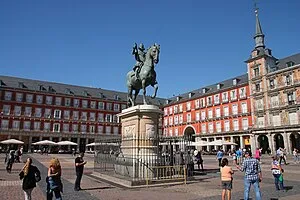

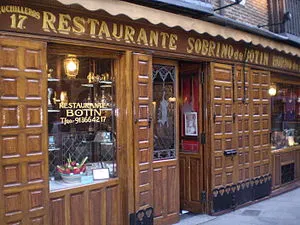
Madrid: A Journey Through Time & Culture

Tour Guide
Ryan Multilingual
Welcome to Madrid! On this GPS guided audio tour, we will visit 20 stops on a route of 5.28km. This tour focusses mainly on general tourism.
Locatello is an app where you can generate personal audio guided tours. Set your preferred distance, guide, language and theme, and a guided tour is created on the spot.
Walking Time
Distance
stops
Language
Tour Stops

calle Mayor
A historic street in Madrid, Calle Mayor was created in the Middle Ages and became the main thoroughfare of the city, housing guilds such as silversmiths and jewelers, and divided into three sections in the 18th century.

Main Square
A porticoed square located in the heart of Madrid, the Plaza Mayor is a major public space that dates back to the 15th century and has been the scene of numerous historical events and celebrations.

Casa de la Panadería
A historic building on the north side of the Plaza Mayor in Madrid, the Casa de la Panadería features a royal Spanish coat of arms from the reign of Carlos II at its top center. It has served as a bakery, offices, royal academies, and municipal facilities throughout its history.

Sobrino de Botín
A historic Spanish restaurant, Sobrino de Botín, is the oldest continuously operating restaurant in the world, founded in 1725. It is known for its traditional recipes, including cochinillo asado and sopa de ajo, and has been featured in notable literary works.
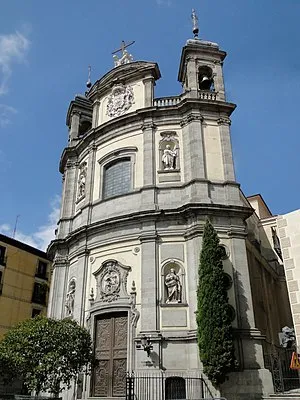
St. Michael's Basilica
A Baroque-style Catholic church and minor basilica, the Pontifical Basilica of St. Michael features an elaborate facade adorned with allegorical statues and a cupola decorated with frescoes depicting the apotheosis of Santos Justo y Pastor.
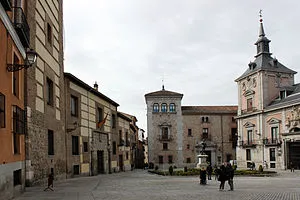
Plaza de la Villa
A historic urban square in central Madrid, housing some of the oldest buildings in the city, including the 15th-century Casa de los Lujanes and the 16th-century Casa de Cisneros.
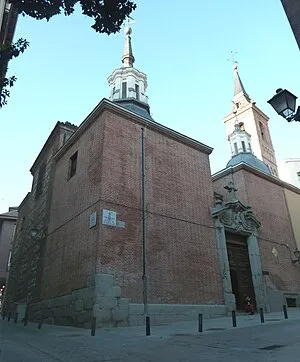
San Nicolas de los Servitas Church, Madrid
A medieval Catholic parish church, San Nicolas de los Servitas Church is one of the oldest and most historic churches in central Madrid, boasting a mix of Gothic, Mudejar, and Herrerian styles.

Almudena Cathedral
A Catholic cathedral, the Almudena Cathedral is the seat of the Archdiocese of Madrid. Its design and construction, spanning over a century, culminated in its consecration by Pope John Paul II in 1993.
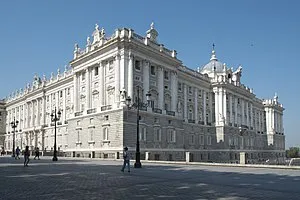
Royal Palace of Madrid
A official residence, the Royal Palace of Madrid is the official principal residence and workplace of the Spanish royal family.
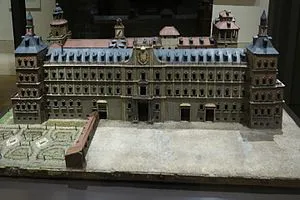
Royal Alcazar of Madrid
A destroyed building or structure is the Royal Alcázar, a former royal palace in Madrid that was extensively damaged and later demolished in the 19th century.

Oriente square
A monumental square in the historic center, designed in 1844 by Narciso Pascual y Colomer, featuring 44 statues of Spanish kings from the medieval period and a monument dedicated to Philip IV of Spain.
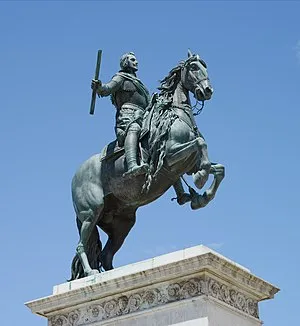
Monument to Philip IV of Spain
A memorial fountain to Philip IV of Spain, featuring an equestrian statue of the king dating back to the 17th century, boasts a daring feat of stability on the rear legs and tail.
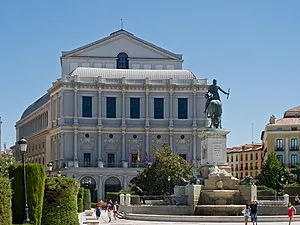
Teatro Real
A monument and one of the most prestigious opera houses in Europe, the Teatro Real was founded by King Ferdinand VII in 1818 and hosts opera performances, concerts, and special events.
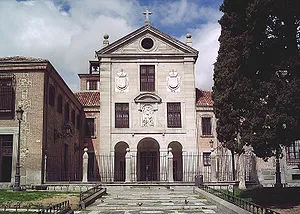
Royal Convent of La Encarnación
A 17th-century monastery and museum built adjacent to the Real Alcázar, featuring works of art, relics, and frescoes, including those by Francisco Bayeu and Luca Giordano, inaugurated in 1616 and now open to the public under the administration of the Patrimonio Nacional.
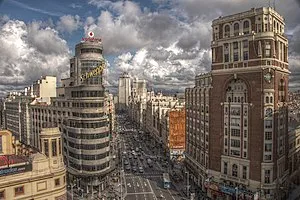
Gran Vía
Gran Vía: A 3.3-kilometer street created in the late 19th century to connect Calle de Alcalá with Plaza de España, featuring historic buildings, movie theaters, and a pedestrianized section.
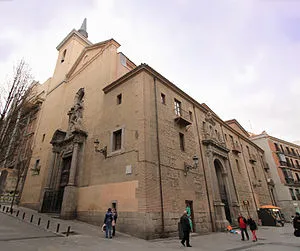
Church of Carmel
A Baroque church, declared Bien de Interés Cultural in 1983, formerly part of the Convento del Carmen Calzado complex.

Madrid
A cultural and economic hub during the Modern Age, Madrid played a significant role in the Spanish monarchy, serving as the capital from 1561 to 1606 and again from 1606 onwards.
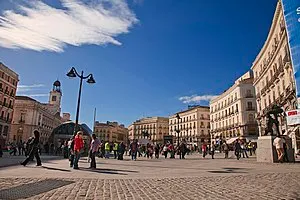
Puerta del Sol
A public square in Madrid, the best-known and busiest place in the city. It is the centre of the radial network of Spanish roads, marked by the famous clock that rings in the new year.
Audio Preview
30 sec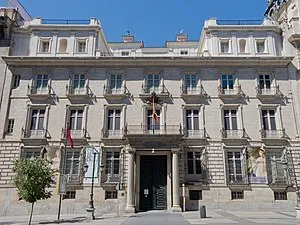
Real Academia de Bellas Artes de San Fernando
A fine art museum and gallery housing a collection of paintings from the 15th to 20th centuries, featuring works by renowned artists such as Velázquez, Goya, and Picasso. The museum showcases a vast array of artistic styles and periods.
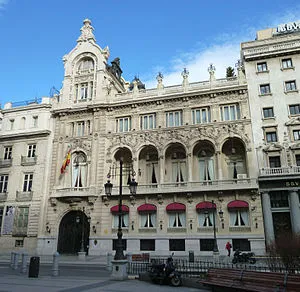
Casino de Madrid
A historic social club established in 1836, the Casino de Madrid is a luxurious venue offering various services to its members, with a significant cultural heritage declared a Bien de Interés Cultural in 1993.
Download App
Experience this tour and many more with our mobile app. Available for iOS and Android.
Audio Preview
Tour Map
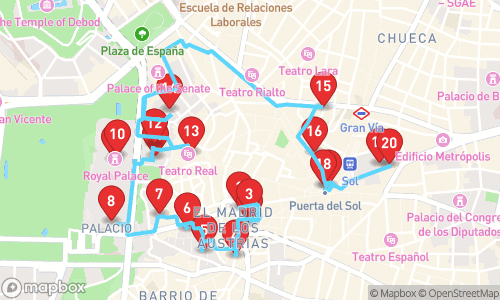
Quick Facts
- ✓GPS-guided navigation
- ✓Professional audio narration
- ✓Offline maps available
- ✓Premium content included
Why Choose This Tour
Expert Local Guide
Narrated by Jenny Multilingual, specializing in general tourism
Flexible Timing
Take the tour at your own pace, any time of day
